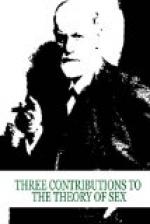[5] Psychoanalysis teaches that there are two paths of object-finding; the first is the one discussed in the text which is guided by the early infantile prototypes. The second is the narcissistic which seeks its own ego and finds it in the other. The latter is of particularly great significance for the pathological outcomes, but does not fit into the connection treated here.
[6] Those to whom this conception appears “wicked” may read Havelock Ellis’s treatise on the relations between mother and child which expresses almost the same ideas (The Sexual Impulse, p. 16).
[7] For the explanation of the origin of the infantile fear I am indebted to a three-year-old boy whom I once heard calling from a dark room: “Aunt, talk to me, I am afraid because it is dark.” “How will that help you,” answered the aunt; “you cannot see anyhow.” “That’s nothing,” answered the child; “if some one talks then it becomes light.”—He was, as we see, not afraid of the darkness but he was afraid because he missed the person he loved, and he could promise to calm down as soon as he was assured of her presence.
[8] Cf. here what was said on page 83 concerning the object selection of the child; the “tender stream.”
[9] The incest barrier probably belongs to the historical acquisitions of humanity and like other moral taboos it must be fixed in many individuals through organic heredity. (Cf. my work, Totem and Taboo, 1913.) Psychoanalytic studies show, however, how intensively the individual struggles with the incest temptations during his development and how frequently he puts them into phantasies and even into reality.




